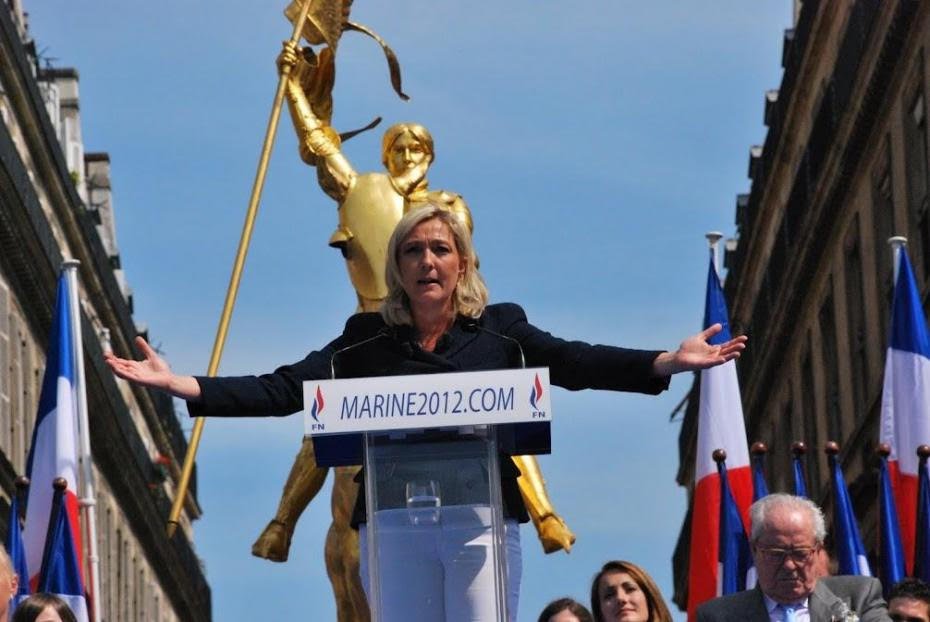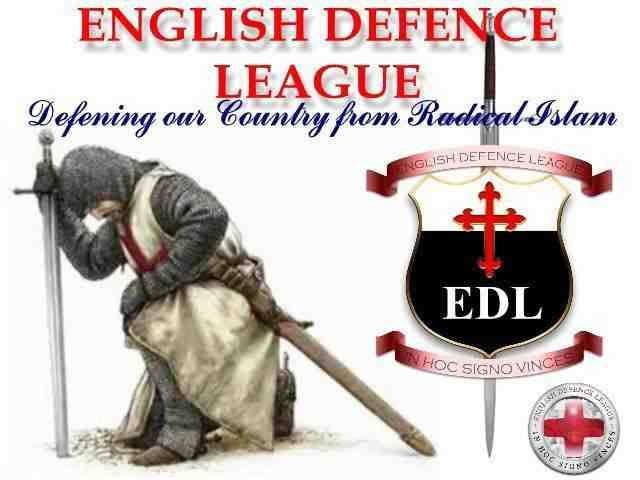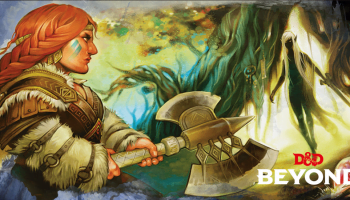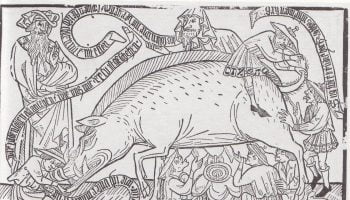This is Part II of The Public Medievalist’s continuing series on Race, Racism and the Middle Ages, written by Dr. Andrew Elliott. His next book, Medievalism, Politics, and Mass Media: Appropriating the Middle Ages in the Twenty-First Century is available for pre-order now.
Read the Introduction to the our series here, and Part I, here.
The Middle Ages have long served as a convenient treasure trove for right-wing nationalism and racism.
Let’s start by looking only at the 20th century. The rise and proliferation of fascism throughout Europe in the 1930s was underpinned by a surprisingly persistent use and appropriation of medieval history and imagery—what scholars call “medievalism.” In her PhD thesis, Flora Ward has described how Francisco Franco, dictator of Spain from 1939 to 1975, relied on the memory of Spain’s medieval past in order to underpin, and legitimise, his rule. Similarly, in a recent volume of Studies in Medievalism Pedro Martins has recently shown how Portugal’s António Sardinha relied on medievalist fantasies of honour and nobility as a way of bypassing Enlightenment ideals of reason and Republicanism.

Jean-Marie Le Pen, former leader of France’s far-right National Front party, made a series of claims indicating that ‘real’ French identity was only valid if it could trace its roots back to the 5th century king of the Franks, Clovis. His daughter, Marine Le Pen, continues his legacy by marching annually to the statue of Joan of Arc to honour ‘proper’ French identity (by which she means white, European and Christian). In what is becoming a family tradition, her niece, Marion, has also been compared to the saint, in an attempt to lay claim to medieval history as the unique property of the far right.
But by far, the most infamous example is, of course, Hitler’s use of the medieval past to promote a nostalgic historical nationalism. Allegedly, according to Uli Linke (p. 198), Hitler even attempted to trace his own genealogy back through Norse mythology to Germanic warriors, and even to Odin himself.
Of course, it is not only the right wing who use the past in this way. Tommaso di Carpegna Falconieri, in his excellent book Medioevo Militante [Militant Middle Ages], outlines how the Middle Ages came to be resurrected in support of a surprising range of political stances. However, it is the Far Right who often find it most fitting, as a way of hiding pseudo-scientific race theories under the disguise of ostensible historical legitimacy.
The real trick, for both Hitler and his successors, was to employ the Middle Ages as a seemingly benign mode of nostalgia. In a tense climate of economic depression, widespread misinformation, wounded national pride, and knee-jerk racism, each successive movement promoted a return to the past. The past they invoked was a putatively shared national identity—shared by those whom they considered racially ‘pure’—that allowed for a nostalgic use of the past. Such ideas are designed to make extremist ideologies more palatable, more mainstream, and more inclusive. They don’t reject other races, they say, they celebrate their own heritage (in reality by rejecting the non-White ‘Other’).
Such appropriations of the Middle Ages have been massively successful. They were so successful, in fact, that the shadow of National Socialism would cast a pall over similar political medievalisms (at least in mainstream politics) for much of the remainder of the twentieth century. Even so, Louise D’Arcens and Clare Monagle have recently identified a ‘comeback’ of medievalism in modern politics. They have pinpointed the ways in which the medieval past has returned to seemingly mainstream discourse. It is present in the mouths of John Howard in Australia, Stephen Harper in Canada, David Cameron in the UK, Marine Le Pen in France, and Donald Trump in the US.
Why Is It Back, and Why Now?
In his book Neomedievalism, Neoconservatism, and the War on Terror Bruce Holsinger offers one part of the answer. Holsinger describes how the logic of the war on terror has reintroduced a series of medievalisms to post-9/11 discourse. Following this logic, it is easy to see how accusations that al Qaeda (and later IS) are ‘medieval’ introduce a stark division between the ‘modern’, ‘evolved’ West and the ‘primitive’, ‘barbaric’ East. This infuses the Bush doctrine (“you are either with us or against us”) with imperialist and orientalist overtones (as John Ganim has persuasively argued in his book Medievalism and Orientalism).
Seeing world leaders standing on the floor of the UN and calling entire cultures (and, by extension, Islam) “medieval” is shocking. This is only somewhat softened by the extent to which insulting something by calling it “medieval” has been normalised by its repetition in political discussion. In my upcoming book, Medievalism, Politics and Mass Media, I describe this phenomenon as ‘banal medievalism.’ The term describes the repetitive use of medievalisms without any real intentions of indicating the actual past, but which nevertheless draw their power from their recognisability and repetition.
A second reason for the return of the Middle Ages in political discourse can be found in the rise of blogging and social media. This has seen proliferation of user-generated content and allows a staggering number of people to join in political discussions online. The lowered barriers of entry are, in themselves, laudable (they are the means by which I am able to write and publish this article). But one of the fringe consequences of the so-called ‘Web 2.0’ is that the use of the Middle Ages no longer needs to be footnoted. We can talk of ‘crusades’ as though there was only one. We can claim to be, or find, King Arthur. We can talk of Robin Hood or Joan of Arc by simply pointing to their Wikipedia pages, which are curated by the crowd, for the crowd. In a post-Truth era, the challenge to authority allows us to make the past mean whatever we want it to mean. Statements are fact-checked afterwards, rather than researched beforehand.
In this climate, the Middle Ages have become particularly fertile ground for the kinds of pseudo-scientific race theories espoused by white supremacist blogs and far-right nationalist groups. In the USA, for example, Neo-nazi website Stormfront [Editor’s note: It is our policy never to link to sites like Stormfront. They don’t deserve the traffic.] illustrate the ways in which a pseudo-historical medieval past can be reworked into a racist fantasy of blood purity and exclusive nationalism. Their propaganda includes a shocking “book” called “A History of the White Race”. It is in fact not a book, but a downloadable PDF, akin to Oslo terrorist Anders Behring Breivik’s “book” in both quality and content. Its most salient feature, however, is that it rates as perhaps the most egregious misuse of history by the far-right today. In their ‘history’, Stormfront literally rewrite the entire history of humankind to suggest a genetically-predetermined supremacy of the supposedly pure white race. They begin by dismissing both evolution and creationism as equally implausible “theories”, then turn to “archaeological evidence” (no evidence at all is actually offered) which “proves” that Homo sapiens (who, they claim without evidence, are solely the ancestors of white Northern Europeans) miraculously survived an ice age. Their fantasy Homo sapiens then “appeared out of the north and swept down through Europe, physically destroying Neanderthal man”. They then go on to rewrite the Middle Ages. In their fantasy Middle Ages, the resistance of Islamic expansion by white European armies was brought about simply because of the natural supremacy of the white race.
It cannot be overstated: this ‘history’ is not only scientifically illogical and completely unsubstantiated; it is historically ludicrous. However, no matter how absurd, claims like these fit perfectly within the right wing’s distortion of history in general, and the Middle Ages in particular. Furthermore, they draw their power not from their factual basis but from their similarities with other neo-Nazi or right-wing sources.
This illustrates a lesson for supposedly ‘post-Truth’ world. That lesson does not come from history, media theory, or journalism. It comes from advertising: truth comes from recognition, repetition, and non-contradiction. The far-right isn’t exploring the truth, they are building a brand.
The Middle Ages in the Far Right-Wing Bubble
So why are the Middle Ages in particular so susceptible to this sort of misuse? One response may be difficult for some scholars to accept, since it means that we have to shoulder some of the responsibility. Scholars design curricula that unduly privilege the written record, and material remains of the European Middle Ages. At the risk of oversimplifying, the abundance of material and cultural remains from a largely white European Middle Ages leads to a disproportionate focus on white, European medieval history. This leads to the (often unwitting) perception that, simply, white history is all the history there ever was.
The extent to which this overprivileging of white Christians dominates the memory of the past can even be found in a throwaway joke in Mel Brooks’ 1993 film, Robin Hood: Men in Tights. In one scene, Robin (Cary Elwes) recruits Ahchoo (Dave Chappelle) as the only black member of his band of Merry Men. On hearing his name, Robin’s servant Blinkin replies: “A Jew? Here?”
The joke only works if you believe that somehow Jews didn’t exist in the European Middle Ages. Obviously this is demonstrably untrue, but gains credence nonetheless given the predominance of white writers in medieval history curricula across the world.
Another part of the response, equally simplistically, is that the medieval past offers particularly useful ideas precisely because of how often the Middle Ages are invoked outside of historical enquiry. Blogs about the Vikings (such as that of Norwegian metal singer Varg Vikernes, with his pompous “Ancestral Cult” blog) groan with references to suppo

sedly pure bloodlines reaching back to the Norsemen and Vikings. They are both genealogically and genetically meaningless, and bear alarming parallels with Hitler’s attempted genealogy back to Odin. Other blogs, such as that of the ‘Traditional Britain Group’, the ‘English Defence League’, or ‘Boudica BPI’ in the UK use common tropes of medievalism to construct a heritage for themselves within an imaginary, exclusionist white history. The far-right British National Party (BNP) run a regular summer camp called “Camp Excalibur,” which celebrates Britain’s white heritage.
The multiple blogs on these topics, exist within a ‘counterjihad filter bubble’ of their own creation. In this bubble, extreme-right figures like Pamela Geller, Robert Spencer, Fjordman, Bat Ye’or, Geert Wilders and Anders Breivik all use medievalism to support their theories of racial identity without encountering opposing voices or contradiction. No footnotes are required: they need only link back to other bloggers in their community. By joining together an imagined community of like-minded followers, the closed circuit of these networks reinforces their paranoia and shuts out any opposing views. Once a person connects to these groups online, the self-referential circularity of those networks offers what appears to be a genuine and powerful alternative to the mainstream media, or mainstream scholarship. Such circularity leads far-right groups to boycott the mainstream media, calling it biased, or lately “fake news,” and has turned them towards attacking the “liberal academy.” They thus over-privilege stories posted by members of their own communities, and mute any inconvenient truths. Recognition, repetition, and non-contradiction.
At the same time, precisely when we need solid journalism and media literacy, news consumption in general has seen a shift towards online sources instead of newspapers, radio or television. A startling report from the Pew Research Center estimated that in 2014, 30% of US adults got their news wholly or mostly from Facebook. The problem comes with the internet’s self-referentiality which ultimately serves to demolish traditionally impartial guarantors of authority and reliability. As Upworthy CEO Eli Pariser argues in his book The Filter Bubble: What The Internet Is Hiding From You, “for most of us now, the difference in authority between a blog post and an article in the New Yorker is much smaller than one would think”.
Owning the Past
In the context of these self-referential filter bubbles, the Middle Ages of the Far Right seems to be rooted in an inclusive celebration of the past, joining a nation together in celebration of heritage. But instead, looking beneath the surface, the misuse of the past forms a powerful strategy rooted in a dangerously exclusive rejection of anyone considered ‘Other’. By calling into doubt the experts who study the Middle Ages, their online pick-and-mix of the past allows them to sidestep accusations of racism by adopting a seemingly celebratory mode of medievalism. In their attempts to dissociate themselves from overtly fascist or neo-Nazi organizations, these networks congregate around the Middle Ages as a shared past and point of contact. The Middle Ages in this context is forcefully conscripted to support their racism and anti-Muslim invective.
Tying these ideas together, it becomes obvious that the normalization of terms like ‘medieval’, to mean barbarous or primitive play perfectly into the right-wing playbook. The insistence by far-right groups that Islam is ‘medieval’ subtly implies that the religion is fundamentally incompatible with modernity. In light of this, their closed-circle media strategies thus offer these groups a dangerous platform to rewrite the past.
In this fraught online landscape, the Middle Ages provides fertile ground for a staggering range of ideologies. In the context of the so-called ‘post-truth’ social landscape before us, amid the deepening mistrust of experts and intellectuals, the rejection of authority means the loss of any ability to talk reasonably about the validity of interpretations of the past. The Middle Ages can mean whatever we—whatever they—want them to mean. The debate is thus not about the past, but about who owns and controls that past. It is for this reason, then, that it is so important that sites like The Public Medievalist and others are able to play a role in the online discussion of complex issues like race, gender, religion and cultural identity in public forums. And scholars have to assume as much responsibility as anyone else to promote inclusivity in their curricula.
Bruce Holsinger suggests—with tongue firmly in cheek—‘we are all medievalists now’. Medievalists, and people interested in the real Middle Ages, must work to ensure that the Middle Ages does not end up meaning whatever a specific ideologue decides it should, but instead reflects all the evidence, particularly all the historical nuances and complexities. It is these nuances and complexities that make history both true and meaningful.
As Nicolas Sarkozy lamented in the ‘tug-of-love’ over Joan of Arc in the 2007 presidential elections, “Joan of Arc is France [and not a symbol of racial exclusion] How could we have let the extreme right confiscate her for so long?”
Continue to Part III of our Series: “Race” in the Trenches
The Public Medievalist does not pay to promote these articles, so we would love it if you shared this with your history-loving friends! Click to share with your friends on Facebook, or Twitter.





The use of the word “medieval” to mean “cruel” or “barbaric” is hardly new. We professional medievalists rail against this in our classrooms constantly, to little effect. Suggestions?
An excellent article, but please note that Stephen Harper is Canadian, not Australian.
Good catch! Thank you for that– I’ve edited the article accordingly, but will keep this up as a record that the error was initially made. Cheers!
Hi Paul, It should read that John Howard is the former Aussie PM and that Harper is the former Cdn PM. I’m afraid you’ve got it the other way around. Sorry to be pedantic.
. Coffee. Need more coffee.
😀 I hear ya.